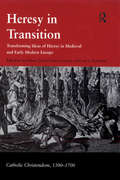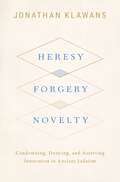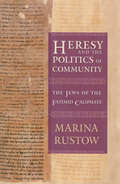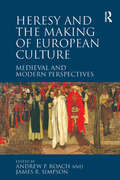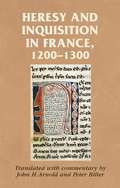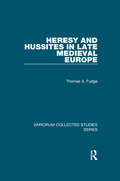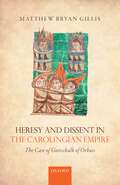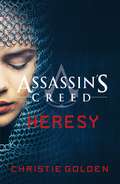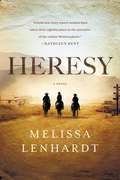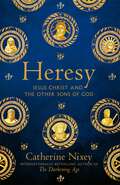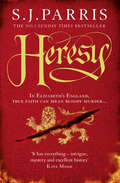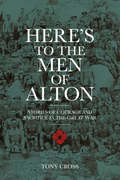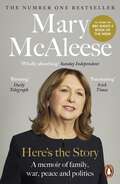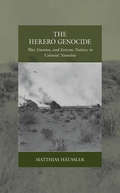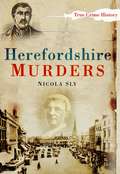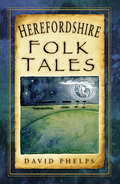- Table View
- List View
Heresy in Transition: Transforming Ideas of Heresy in Medieval and Early Modern Europe (Catholic Christendom, 1300-1700)
by John Christian Laursen Cary J. NedermanThe concept of heresy is deeply rooted in Christian European culture. The palpable increase in incidences of heresy in the Middle Ages may be said to directly relate to the Christianity's attempts to define orthodoxy and establish conformity at its centre, resulting in the sometimes forceful elimination of Christian sects. In the transition from medieval to early modern times, however, the perception of heresy underwent a profound transformation, ultimately leading to its decriminalization and the emergence of a pluralistic religious outlook. The essays in this volume offer readers a unique insight into this little-understood cultural shift. Half of the chapters investigate the manner in which the church and its attendant civil authorities defined and proscribed heresy, whilst the other half focus on the means by which early modern writers sought to supersede such definition and proscription. The result of these investigations is a multifaceted historical account of the construction and serial reconstruction of one of the key categories of European theological, juristic and political thought. The contributors explore the role of nationalism and linguistic identity in constructions of heresy, its analogies with treason and madness, the role of class and status in the responses to heresy. In doing so they provide fascinating insights into the roots of the historicization of heresy and the role of this historicization in the emergence of religious pluralism.
Heresy in Transition: Transforming Ideas of Heresy in Medieval and Early Modern Europe (Catholic Christendom, 1300-1700)
by John Christian Laursen Cary J. NedermanThe concept of heresy is deeply rooted in Christian European culture. The palpable increase in incidences of heresy in the Middle Ages may be said to directly relate to the Christianity's attempts to define orthodoxy and establish conformity at its centre, resulting in the sometimes forceful elimination of Christian sects. In the transition from medieval to early modern times, however, the perception of heresy underwent a profound transformation, ultimately leading to its decriminalization and the emergence of a pluralistic religious outlook. The essays in this volume offer readers a unique insight into this little-understood cultural shift. Half of the chapters investigate the manner in which the church and its attendant civil authorities defined and proscribed heresy, whilst the other half focus on the means by which early modern writers sought to supersede such definition and proscription. The result of these investigations is a multifaceted historical account of the construction and serial reconstruction of one of the key categories of European theological, juristic and political thought. The contributors explore the role of nationalism and linguistic identity in constructions of heresy, its analogies with treason and madness, the role of class and status in the responses to heresy. In doing so they provide fascinating insights into the roots of the historicization of heresy and the role of this historicization in the emergence of religious pluralism.
HERESY,FORGERY,NOVELTY C: Condemning, Denying, and Asserting Innovation in Ancient Judaism
by Jonathan KlawansIt is commonly asserted that heresy is a Christian invention that emerged in late antiquity as Christianity distinguished itself from Judaism. Heresy, Forgery, Novelty probes ancient Jewish disputes regarding religious innovation and argues that Christianity's heresiological impulse is in fact indebted to Jewish precedents. In this book, Jonathan Klawans demonstrates that ancient Jewish literature displays a profound unease regarding religious innovation. The historian Josephus condemned religious innovation outright, and later rabbis valorize the antiquity of their traditions. The Dead Sea sectarians spoke occasionally-and perhaps secretly-of a "new covenant," but more frequently masked newer ideas in rhetorics of renewal or recovery. Other ancient Jews engaged in pseudepigraphy-the false attribution of recent works to prophets of old. The flourishing of such religious forgeries further underscores the dangers associated with religious innovation. As Christianity emerged, the discourse surrounding religious novelty shifted dramatically. On the one hand, Christians came to believe that Jesus had inaugurated a "new covenant," replacing what came prior. On the other hand, Christian writers followed their Jewish predecessors in condemning heretics as dangerous innovators, and concealing new works in pseudepigraphic garb. In its open, unabashed embrace of new things, Christianity parts from Judaism. Christianity's heresiological condemnation of novelty, however, displays continuity with prior Jewish traditions. Heresy, Forgery, Novelty reconsiders and offers a new interpretation of the dynamics of the split between Judaism and Christianity.
Heresy, Forgery, Novelty: Condemning, Denying, and Asserting Innovation in Ancient Judaism
by Jonathan KlawansIt is commonly asserted that heresy is a Christian invention that emerged in late antiquity as Christianity distinguished itself from Judaism. Heresy, Forgery, Novelty probes ancient Jewish disputes regarding religious innovation and argues that Christianity's heresiological impulse is in fact indebted to Jewish precedents. In this book, Jonathan Klawans demonstrates that ancient Jewish literature displays a profound unease regarding religious innovation. The historian Josephus condemned religious innovation outright, and later rabbis valorize the antiquity of their traditions. The Dead Sea sectarians spoke occasionally-and perhaps secretly-of a "new covenant," but more frequently masked newer ideas in rhetorics of renewal or recovery. Other ancient Jews engaged in pseudepigraphy-the false attribution of recent works to prophets of old. The flourishing of such religious forgeries further underscores the dangers associated with religious innovation. As Christianity emerged, the discourse surrounding religious novelty shifted dramatically. On the one hand, Christians came to believe that Jesus had inaugurated a "new covenant," replacing what came prior. On the other hand, Christian writers followed their Jewish predecessors in condemning heretics as dangerous innovators, and concealing new works in pseudepigraphic garb. In its open, unabashed embrace of new things, Christianity parts from Judaism. Christianity's heresiological condemnation of novelty, however, displays continuity with prior Jewish traditions. Heresy, Forgery, Novelty reconsiders and offers a new interpretation of the dynamics of the split between Judaism and Christianity.
Heresy and the Politics of Community: The Jews of the Fatimid Caliphate (Conjunctions of Religion and Power in the Medieval Past)
by Marina RustowIn a book with a bold new view of medieval Jewish history, written in a style accessible to nonspecialists and students as well as to scholars in the field, Marina Rustow changes our understanding of the origins and nature of heresy itself. Scholars have long believed that the Rabbanites and Qaraites, the two major Jewish groups under Islamic rule, split decisively in the tenth century and from that time forward the minority Qaraites were deemed a heretical sect. Qaraites affirmed a right to decide matters of Jewish law free from centuries of rabbinic interpretation; the Rabbanites, in turn, claimed an unbroken chain of scholarly tradition.Rustow draws heavily on the Cairo Geniza, a repository of papers found in a Rabbanite synagogue, to show that despite the often fierce arguments between the groups, they depended on each other for political and financial support and cooperated in both public and private life. This evidence of remarkable interchange leads Rustow to the conclusion that the accusation of heresy appeared sporadically, in specific contexts, and that the history of permanent schism was the invention of polemicists on both sides. Power shifted back and forth fluidly across what later commentators, particularly those invested in the rabbinic claim to exclusive authority, deemed to have been sharply drawn boundaries. Heresy and the Politics of Community paints a portrait of a more flexible medieval Eastern Mediterranean world than has previously been imagined and demonstrates a new understanding of the historical meanings of charges of heresy against communities of faith. Historians of premodern societies will find that, in her fresh approach to medieval Jewish and Islamic culture, Rustow illuminates a major issue in the history of religions.
Heresy and the Making of European Culture: Medieval and Modern Perspectives
by Andrew P. Roach James R. SimpsonScholars and analysts seeking to illuminate the extraordinary creativity and innovation evident in European medieval cultures and their afterlives have thus far neglected the important role of religious heresy. The papers collected here - reflecting the disciplines of history, literature, theology, philosophy, economics and law - examine the intellectual and social investments characteristic of both deliberate religious dissent such as the Cathars of Languedoc, the Balkan Bogomils, the Hussites of Bohemia and those who knowingly or unknowingly bent or broke the rules, creating their own 'unofficial orthodoxies'. Attempts to understand, police and eradicate all these, through methods such as the Inquisition, required no less ingenuity. The ambivalent dynamic evident in the tensions between coercion and dissent is still recognisable and productive in the world today.
Heresy and the Making of European Culture: Medieval and Modern Perspectives
by Andrew P. Roach James R. SimpsonScholars and analysts seeking to illuminate the extraordinary creativity and innovation evident in European medieval cultures and their afterlives have thus far neglected the important role of religious heresy. The papers collected here - reflecting the disciplines of history, literature, theology, philosophy, economics and law - examine the intellectual and social investments characteristic of both deliberate religious dissent such as the Cathars of Languedoc, the Balkan Bogomils, the Hussites of Bohemia and those who knowingly or unknowingly bent or broke the rules, creating their own 'unofficial orthodoxies'. Attempts to understand, police and eradicate all these, through methods such as the Inquisition, required no less ingenuity. The ambivalent dynamic evident in the tensions between coercion and dissent is still recognisable and productive in the world today.
Heresy and inquisition in France, 1200–1300 (Manchester Medieval Sources)
by Rosemary Horrox John H. Arnold Peter Biller Simon MacleanHeresy and inquisition in France, 1200–1300 is an invaluable collection of primary sources in translation, aimed at students and academics alike. It provides a wide array of materials on both heresy (Cathars and Waldensians) and the persecution of heresy in medieval France. The book is divided into eight sections, each devoted to a different genre of source material. It contains substantial material pertaining to the setting up and practice of inquisitions into heretical wickedness, and a large number of translations from the registers of inquisition trials. Each source is introduced fully and is accompanied by references to useful modern commentaries. The study of heresy and inquisition has always aroused considerable scholarly debate; with this book, students and scholars can form their own interpretations of the key issues, from the texts written in the period itself.
Heresy and Hussites in Late Medieval Europe
by Thomas A. FudgeThe followers of the martyred Bohemian priest Jan Hus (1371-1415) formed one of the greatest challenges to the medieval Latin Church. Branded as heretics, outlawed, then forced to fight for their faith as well as their lives, the Hussites occupy one of the most colorful and challenging chapters of European religious history. The essays reprinted in this book (along with one here first published in English and additional notes) explore the essence of the early Hussite movement by focusing on the nature and development of heresy both as accusation and identity. Heresy and Hussites in Late Medieval Europe first examines the definition of heresy, and its comparative nature across Europe. It investigates the unique practices of popular religion in local communities, while examining theology and its unavoidable conflicts. The repressive policy of crusade and the growth of martyrdom with its inevitable contribution to the formation of Hussite history is explored. The social application of religious ideas, its revolutionary outcomes, along with the intentional use of art in pedagogy and propaganda, situates the Czech heretics in the fifteenth century. An examination of leading personalities, together with the eventual and more formal church administration, rounds out the study of this remarkable era.
Heresy and Hussites in Late Medieval Europe
by Thomas A. FudgeThe followers of the martyred Bohemian priest Jan Hus (1371-1415) formed one of the greatest challenges to the medieval Latin Church. Branded as heretics, outlawed, then forced to fight for their faith as well as their lives, the Hussites occupy one of the most colorful and challenging chapters of European religious history. The essays reprinted in this book (along with one here first published in English and additional notes) explore the essence of the early Hussite movement by focusing on the nature and development of heresy both as accusation and identity. Heresy and Hussites in Late Medieval Europe first examines the definition of heresy, and its comparative nature across Europe. It investigates the unique practices of popular religion in local communities, while examining theology and its unavoidable conflicts. The repressive policy of crusade and the growth of martyrdom with its inevitable contribution to the formation of Hussite history is explored. The social application of religious ideas, its revolutionary outcomes, along with the intentional use of art in pedagogy and propaganda, situates the Czech heretics in the fifteenth century. An examination of leading personalities, together with the eventual and more formal church administration, rounds out the study of this remarkable era.
Heresy and Dissent in the Carolingian Empire: The Case of Gottschalk of Orbais
by Matthew Bryan GillisHeresy and Dissent in the Carolingian Empire recounts the history of an exceptional ninth-century religious outlaw, Gottschalk of Orbais. Frankish Christianity required obedience to ecclesiastical superiors, voluntary participation in reform, and the belief that salvation was possible for all baptized believers. Yet Gottschalk-a mere priest-developed a controversial, Augustinian-based theology of predestination, claiming that only divine election through grace enabled eternal life. Gottschalk preached to Christians within the Frankish empire-including bishops-and non-Christians beyond its borders, scandalously demanding they confess his doctrine or be revealed as wicked reprobates. Even after his condemnations for heresy in the late 840s, Gottschalk continued his activities from prison thanks to monks who smuggled his pamphlets to a subterranean community of supporters. This study reconstructs the career of the Carolingian Empire's foremost religious dissenter in order to imagine that empire from the perspective of someone who worked to subvert its most fundamental beliefs. Examining the surviving evidence (including his own writings), Matthew Gillis analyzes Gottschalk's literary and spiritual self-representations, his modes of argument, his prophetic claims to martyrdom and miraculous powers, and his shocking defiance to bishops as strategies for influencing contemporaries in changing political circumstances. In the larger history of medieval heresy and dissent, Gottschalk's case reveals how the Carolingian Empire preserved order within the church through coercive reform. The hierarchy compelled Christians to accept correction of perceived sins and errors, while punishing as sources of spiritual corruption those rare dissenters who resisted its authority.
Heresy and Dissent in the Carolingian Empire: The Case of Gottschalk of Orbais
by Matthew Bryan GillisHeresy and Dissent in the Carolingian Empire recounts the history of an exceptional ninth-century religious outlaw, Gottschalk of Orbais. Frankish Christianity required obedience to ecclesiastical superiors, voluntary participation in reform, and the belief that salvation was possible for all baptized believers. Yet Gottschalk-a mere priest-developed a controversial, Augustinian-based theology of predestination, claiming that only divine election through grace enabled eternal life. Gottschalk preached to Christians within the Frankish empire-including bishops-and non-Christians beyond its borders, scandalously demanding they confess his doctrine or be revealed as wicked reprobates. Even after his condemnations for heresy in the late 840s, Gottschalk continued his activities from prison thanks to monks who smuggled his pamphlets to a subterranean community of supporters. This study reconstructs the career of the Carolingian Empire's foremost religious dissenter in order to imagine that empire from the perspective of someone who worked to subvert its most fundamental beliefs. Examining the surviving evidence (including his own writings), Matthew Gillis analyzes Gottschalk's literary and spiritual self-representations, his modes of argument, his prophetic claims to martyrdom and miraculous powers, and his shocking defiance to bishops as strategies for influencing contemporaries in changing political circumstances. In the larger history of medieval heresy and dissent, Gottschalk's case reveals how the Carolingian Empire preserved order within the church through coercive reform. The hierarchy compelled Christians to accept correction of perceived sins and errors, while punishing as sources of spiritual corruption those rare dissenters who resisted its authority.
Heresy: Assassin's Creed Book 9 (Assassin's Creed #9)
by Christie GoldenThe new book set in the universe of Assassin's Creed. Reliving the memories of his ancestor who fought beside Joan of Arc, high-ranking Templar Simon Hathaway slowly uncovers secrets of the past that could dangerously impact his present . . . and that of the entire Templar order.An endless conflict. An old wrong. A new revelation. Simon Hathaway, member of the Templar Inner Sanctum, brings a cool head and detached manner to his new role as Head of Abstergo Industry's Historical Research Division.But Simon also has an insatiable curiosity, and is fascinated by the thought of experiencing history first-hand through his ancestor Gabriel Laxart, who fought alongside the legendary Joan of Arc.When he enters the newly-designed Animus for its initial project, Simon finds himself unprepared for what he discovers: how deep the conflict between the Templars and the Assassins goes, and what his ancestor is willing to do for the woman he loves. And as he slowly uncovers secrets of the past, Simon is confronted with the most dangerous truth of all: Who is the heretic . . . and who is the true believer?
Heresy
by Melissa Lenhardt"An all-out women-driven, queer, transgender, multiracial takeover of the Old West . . . and that's exactly what Melissa Lenhardt delivers in her unapologetically badass western, Heresy." - New York Times"Lenhardt has created a bold new story where women have taken their rightful place in the narrative of the Outlaw Western genre; where wit, wisdom and wiles could mean the difference between life and death, and where the fellowship of women bested every challenge." - Kathleen KentMargaret Parker and Hattie LaCour never intended to turn outlaw. After being run off their ranch by a greedy cattleman, their family is left destitute. As women alone they have few choices: marriage, lying on their backs for money, or holding a gun. For Margaret and Hattie the choice is simple. With their small makeshift family, the gang pulls off a series of heists across the West.Though the newspapers refuse to give the female gang credit, their exploits don't go unnoticed. Pinkertons are on their trail, a rival male gang is determined to destroy them, and secrets among the group threaten to tear them apart. Now, Margaret and Hattie must find a way to protect their family, finish one last job, and avoid the hangman's noose."Readers who relish an unusual narrative structure will enjoy this unique take on the traditional western." - BooklistFor more from Melissa Lenhardt, check out:The Sawbones SeriesSawbonesBlood OathBadlands
Heresy
by Melissa Lenhardt"An all-out women-driven, queer, transgender, multiracial takeover of the Old West . . . and that's exactly what Melissa Lenhardt delivers in her unapologetically badass western, Heresy." - New York Times"Lenhardt has created a bold new story where women have taken their rightful place in the narrative of the Outlaw Western genre; where wit, wisdom and wiles could mean the difference between life and death, and where the fellowship of women bested every challenge." -- Kathleen KentMargaret Parker and Hattie LaCour never intended to turn outlaw. After being run off their ranch by a greedy cattleman, their family is left destitute. As women alone they have few choices: marriage, lying on their backs for money, or holding a gun. For Margaret and Hattie the choice is simple. With their small makeshift family, the gang pulls off a series of heists across the West.Though the newspapers refuse to give the female gang credit, their exploits don't go unnoticed. Pinkertons are on their trail, a rival male gang is determined to destroy them, and secrets among the group threaten to tear them apart. Now, Margaret and Hattie must find a way to protect their family, finish one last job, and avoid the hangman's noose."Readers who relish an unusual narrative structure will enjoy this unique take on the traditional western." -- Booklist
Heresy: Jesus Christ and the Other Sons of God
by Catherine Nixey‘In the beginning was the Word,’ says the Gospel of John. This sentence – and the words of all four gospels – is central to the teachings of the Christian church and has shaped Western art, literature and language, and the Western mind.Yet in the years after the death of Christ there was not merely one word, nor any consensus as to who Jesus was or why he had mattered. There were many different Jesuses, among them the aggressive Jesus who scorned his parents and crippled those who opposed him, the Jesus who sold his twin into slavery and the Jesus who had someone crucified in his stead.Moreover, in the early years of the first millennium there were many other saviours, many sons of gods who healed the sick and cured the lame. But as Christianity spread, they were pronounced unacceptable – even heretical – and they faded from view. Now, in Heresy, Catherine Nixey tells their extraordinary story, one of contingency, chance and plurality. It is a story about what might have been.
Heresy: Heresy, Prophecy, Sacrilege (Giordano Bruno #1)
by S. ParrisThe first book in the No. 1 Sunday Times bestselling series following Giordano Bruno, set at the time of Queen Elizabeth I
Here's to the Men of Alton: Stories of Courage and Sacrifice in the Great War
by Tony CrossDuring the Great War almost 650 men enlisted from the small market town of Alton, Hampshire. These soldiers served all over the globe, including the Western Front, India, Mesopotamia, Salonika, Turkey and Russia, and were never the same again; some choosing to tell their stories, others desperately trying to forget what they had experienced. But they were the lucky ones: around a third of those who left for distant shores were never to return and instead lie buried in cemeteries across the world. The stories these men couldn’t tell themselves are uncovered here as a monument to their bravery and sacrifice. Here’s to the Men of Alton is a collection of personal accounts of courage and hardship which provides a lasting tribute to those ordinary men who gave their lives for King and Country.
Here’s the Story: A Memoir
by Mary McAleeseThe groundbreaking two-term President of Ireland tells the stories of her lifeWhen a young Mary McAleese told a priest that she planned to become a lawyer, the priest dismissed the idea: she knew no one in the law, and she was female. The reality of what she went on to achieve - despite those obstacles, and despite a sectarian attack that forced her family to flee their home - is even more improbable.In this luminous memoir, Mary McAleese traces that astonishing arc: from the tight streets of north Belfast, to a professorship in Dublin while still in her twenties, behind-the-scenes work on the peace process, and two triumphant terms as President of Ireland. She writes of her encounters with prime ministers, popes and royalty with the same easy candour and intimacy with which she describes her childhood. And her account of the latest act in her remarkable career - quietly pursuing a doctorate, and loudly opposing the misogyny of the Catholic Church - is inspiring.Here's the Story is warm, witty, often surprising and relentlessly fascinating: an extraordinarily intimate memoir by one of the most remarkable public figures of our time.
The Herero Genocide: War, Emotion, and Extreme Violence in Colonial Namibia (War and Genocide #31)
by Matthias HäusslerDrawing on previously inaccessible and overlooked archival sources, The Herero Genocide undertakes a groundbreaking investigation into the war between colonizer and colonized in what was formerly German South-West Africa and is today the nation of Namibia. In addition to its eye-opening depictions of the starvation, disease, mass captivity, and other atrocities suffered by the Herero, it reaches surprising conclusions about the nature of imperial dominion, showing how the colonial state’s genocidal posture arose from its own inherent weakness and military failures. The result is an indispensable account of a genocide that has been neglected for too long.
The Herero Genocide: War, Emotion, and Extreme Violence in Colonial Namibia (War and Genocide #31)
by Matthias HäusslerDrawing on previously inaccessible and overlooked archival sources, The Herero Genocide undertakes a groundbreaking investigation into the war between colonizer and colonized in what was formerly German South-West Africa and is today the nation of Namibia. In addition to its eye-opening depictions of the starvation, disease, mass captivity, and other atrocities suffered by the Herero, it reaches surprising conclusions about the nature of imperial dominion, showing how the colonial state’s genocidal posture arose from its own inherent weakness and military failures. The result is an indispensable account of a genocide that has been neglected for too long.
The Herero Genocide: War, Emotion, and Extreme Violence in Colonial Namibia (War and Genocide #31)
by Matthias HäusslerDrawing on previously inaccessible and overlooked archival sources, The Herero Genocide undertakes a groundbreaking investigation into the war between colonizer and colonized in what was formerly German South-West Africa and is today the nation of Namibia. In addition to its eye-opening depictions of the starvation, disease, mass captivity, and other atrocities suffered by the Herero, it reaches surprising conclusions about the nature of imperial dominion, showing how the colonial state’s genocidal posture arose from its own inherent weakness and military failures. The result is an indispensable account of a genocide that has been neglected for too long.
The Herero Genocide: War, Emotion, and Extreme Violence in Colonial Namibia (War and Genocide #31)
by Matthias HäusslerDrawing on previously inaccessible and overlooked archival sources, The Herero Genocide undertakes a groundbreaking investigation into the war between colonizer and colonized in what was formerly German South-West Africa and is today the nation of Namibia. In addition to its eye-opening depictions of the starvation, disease, mass captivity, and other atrocities suffered by the Herero, it reaches surprising conclusions about the nature of imperial dominion, showing how the colonial state’s genocidal posture arose from its own inherent weakness and military failures. The result is an indispensable account of a genocide that has been neglected for too long.
Herefordshire Murders
by Nicola SlyHerefordshire Murders brings together twenty-eight murderous tales, some which were little known outside the county and others which made national headlines. Herefordshire was home to one of Britain’s most infamous murderers, Major Herbert Rowse Armstrong, who, in 1921, poisoned his wife and attempted to poison a fellow solicitor in Hay-on-Wye. However, the county has also experienced many lesser known murders. They include the case of two-year-old Walter Frederick Steers, brutally killed in Little Hereford in 1891; eighty-seven-year-old Phillip Ballard, who died at the hands of two would-be burglars in Tupsley in 1887; Jane Haywood, murdered by her husband near Leominster in 1903; and the shooting of two sisters at Burghill Court, near Hereford, by their butler in 1926. Nicola Sly’s carefully researched and enthralling text will appeal to everyone interested in the shady side of Herefordshire’s history.
Herefordshire Folk Tales (Folk Tales Ser.)
by David PhelpsThis selection of thirty folk tales and legends from the deepest corners of Herefordshire reflect the wit and wisdom of the countryside and its people. There are strange happenings in the peaceful county, formed from early attempts to explain the natural and spiritual world, as well as dark tales of revenge resulting from clashes on the Welsh Borders. From the Saxon king of East Anglia who became the patron saint of Hereford Cathedral, and the story of the black hound of Hergest Court which inspired Arthur Conan Doyle, to a medieval love story, these gripping tales have stood the test of time, and remain classic texts which will be enjoyed time and again by modern readers.
